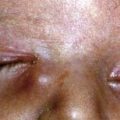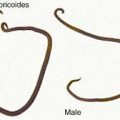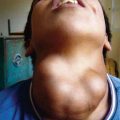Chapter 10 The Preschool Years
Physical Development
Somatic and brain growth slows by the end of the 2nd yr of life, with corresponding decreases in nutritional requirements and appetite, and the emergence of “picky” eating habits (see Table 13-1). Increases of ~2 kg (4-5 lb) in weight and 7-8 cm (2-3 in) in height per yr are expected. Birthweight quadruples by  yr of age. An average 4 yr old weighs 40 lb and is 40 in tall. The head will grow only an additional 5 cm between ages 3 and 18 yr. Current growth charts, with growth parameters, can be found on the Centers for Disease Control and Prevention website (www.cdc.gov/nchs) and in Chapter 13. Children with early adiposity rebound (increase in body mass index) are at increased risk for adult obesity.
yr of age. An average 4 yr old weighs 40 lb and is 40 in tall. The head will grow only an additional 5 cm between ages 3 and 18 yr. Current growth charts, with growth parameters, can be found on the Centers for Disease Control and Prevention website (www.cdc.gov/nchs) and in Chapter 13. Children with early adiposity rebound (increase in body mass index) are at increased risk for adult obesity.
Growth of sexual organs is commensurate with somatic growth. The preschooler has genu valgum (knock-knees) and mild pes planus (flatfoot). The torso slims as the legs lengthen. Physical energy peaks, and the need for sleep declines to 11-13 hr/24 hr, with the child eventually dropping the nap (see Fig. 8-1). Visual acuity reaches 20/30 by age 3 yr and 20/20 by age 4 yr. All 20 primary teeth have erupted by 3 yr of age (Chapter 299).
Most children walk with a mature gait and run steadily before the end of their 3rd yr (see Table 9-1). Beyond this basic level, there is wide variation in ability as the range of motor activities expands to include throwing, catching, and kicking balls; riding on bicycles; climbing on playground structures; dancing; and other complex pattern behaviors. Stylistic features of gross motor activity, such as tempo, intensity, and cautiousness, also vary significantly. Although toddlers may walk with different styles, toe walking should not persist.
Bowel and bladder control emerge during this period, with “readiness” for toileting having large individual and cultural variation. Girls tend to train faster and earlier than boys. Bed-wetting is normal up to age 4 yr in girls and age 5 yr in boys (Chapter 21.3). Many children master toileting with ease, particularly once they are able to verbalize their bodily needs. For others, toilet training can involve a protracted power struggle. Refusal to defecate in the toilet or potty is relatively common and can lead to constipation and parental frustration. Defusing the issue with a temporary cessation of training (and a return to diapers) often allows toilet mastery to proceed.
Language, Cognition, and Play
Language
It is important to distinguish between speech (the production of intelligible sounds) and language, which refers to the underlying mental act. Language includes both expressive and receptive functions. Receptive language (understanding) varies less in its rate of acquisition than does expressive language; therefore, it has greater prognostic importance (Chapters 14 and 32).
Cognition
The preschool period corresponds to Piaget’s preoperational (prelogical) stage, characterized by magical thinking, egocentrism, and thinking that is dominated by perception, not abstraction (see Table 6-2). Magical thinking includes confusing coincidence with causality, animism (attributing motivations to inanimate objects and events), and unrealistic beliefs about the power of wishes. A child might believe that people cause it to rain by carrying umbrellas, that the sun goes down because it is tired, or that feeling resentment toward a sibling can actually make that sibling sick. Egocentrism refers to a child’s inability to take another’s point of view and does not connote selfishness. A child might try to comfort an adult who is upset by bringing him or her a favorite stuffed animal. After 2 yr of age, the child develops a concept of herself or himself as an individual and senses the need to feel “whole.”
Emotional and Moral Development
Curiosity about genitals and adult sexual organs is normal, as is masturbation. Excessive masturbation interfering with normal activity, acting out sexual intercourse, extreme modesty, or mimicry of adult seductive behavior all suggests the possibility of sexual abuse or inappropriate exposure (Chapter 37.1). Modesty appears gradually between 4 and 6 yr of age, with wide variations among cultures and families. Parents should begin to teach children about “private” areas before school entry.
Anderson LM, Shinn C, Fullilove MT, et al. The effectiveness of early childhood development programs: a systematic review. Am J Prev Med. 2003;24(3S):32-46.
Busari JO, Weggelaar NM. How to investigate and manage the child who is slow to speak. BMJ. 2004;328:272-276.
Dixon SD. Two years: language emerges. In: Dixon SD, Stein MT, editors. Encounters with children: pediatric behavior and development. St Louis: Mosby; 2000:300-326.
Dufresne T, Masny D. Multiple literacies: linking the research on bilingualism and biliteracies to the practical. Paediatr Child Health. 2006;11(9):577-579.
Fraiberg S. The magic years. New York: Scribner; 1959.
Gelman SA. Psychological essentialism in children. Trends Cogn Sci. 2004;8(9):404-409.
Gopnik A, Sobel DM, Schulz LE, et al. Causal learning mechanisms in very young children: two-, three-, and four-year-olds infer causal relations from patterns of variation and covariation. Dev Psychol. 2001;37(5):620-629.
Gracia E, Herrero J. Beliefs in the necessity of corporal punishment of children and public perceptions of child physical abuse as a social problem. Child Abuse Negl. 2008;32(11):1058-1062.
National Institute of Child Health and Human Development Early Child Care Research Network. Duration and developmental timing of poverty and children’s cognitive and social development from birth through third grade. Child Dev. 2005;76:795-810.
Polaha J, Warzak WJ, Dittmer-Mcmahon K. Toilet training in primary care: current practice and recommendations from behavioral pediatrics. J Dev Behav Pediatr. 2002;23:424-429.
Schickedanz JA. Much more than the ABCs: the early stages of reading and writing. Washington, DC: National Association for the Education of Young Children (NAEYC); 1999.
Thakkar RR, Garrison MM, Christakis DA. A systematic review for the effects of television viewing by infants and preschoolers. Pediatrics. 2006;118:2025-2031.
Vermandel A, Weyler J, De Wachter S, et al. Toilet training of healthy young toddlers: a randomized trial between a daytime wetting alarm and timed potty training. J Dev Behav Pediatr. 2008;29:191-196.






